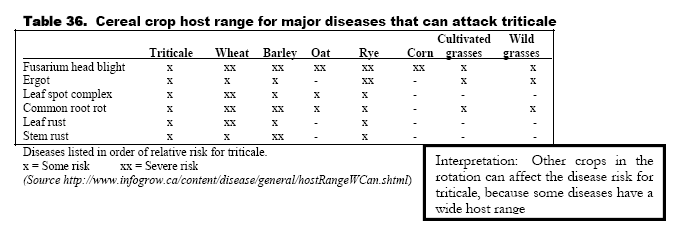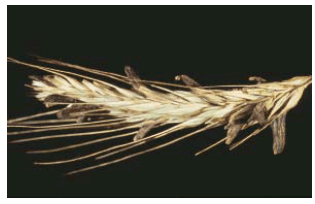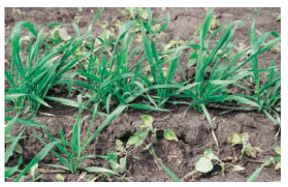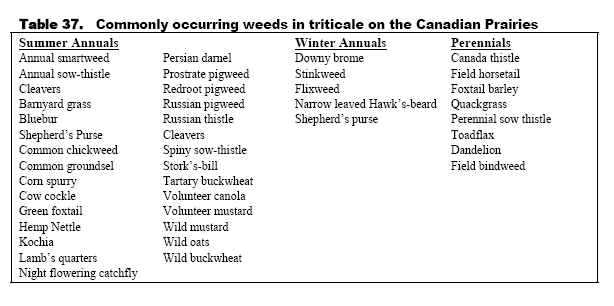| | Diseases of triticale | Insects and pests of triticale | Weed management in triticale
Diseases of Triticale
Triticale usually has a very low incidence of disease problems compared to other cereals. It is not susceptible to barley scald, making it an excellent alternative for grain or forage/silage use in continuous barley rotations.
Triticale has an excellent resistance level to rusts and to powdery mildew, but shares many other minor diseases in common with other cereal crops. Crop rotations that include triticale should be lengthened so that cereal crops that are at risk from the same diseases are never grown back-to-back (Table 36). Using proper crop rotation, disease-free seed, and seed treatments will solve most disease problems before they occur.

The only registered seed treatment approved for use on triticale is Vita flo 280® for damping off, seed decay and seedling blight.
Management practices that result in rapid crop establishment, proper crop nutrition and early vigorous growth also produce crops with a better ability to tolerate disease infestation. In the case of ergot infection in cereals, there is considerable evidence linking high levels of ergot infection with sub-optimal levels of copper availability in the soil. Soil tests for micronutrients are required to check soil copper levels when this deficiency is suspected.
Due to triticale’s excellent leaf and head disease tolerance, the use of fungicides for control of infection has not proven necessary in Western Canadian triticale production.
Fusarium head blight or FHB (Fusarium graminearum) is the most serious disease threat to triticale, especially in the eastern prairies. Growers need to practice a high level of seed and crop rotational management to minimize infection risk. Special post-crop measures are required in any field where this disease occurs to minimize further disease spread to other crops. In Alberta, all triticale seed must be tested for Fusarium graminearum before cleaning at municipal plants and seeding.
When best management practices are applied, similar to those recommended for rye, the risk of ergot infection in triticale should be no more than for wheat:
- Use ergot-free seed, planted in ergot free fields in an extended rotation that gives yearly separation between ergot-susceptible crops.
- Mow grassy headlands to avoid infection from grasses spreading into the edges of triticale production fields.
- Ensure soil copper levels are adequate. High ergot levels are a good indication of low copper.
There are other diseases that occur rarely or at an insignificant level in Western Canadian triticale. These include:
- Bacterial blight
- Barley yellow dwarf virus
- Cochliobolus and browning root rots
- Cephalosporium stripe
- Sharp eyespot
- Spot blotch (and blackpoint)
- Take-all
- Tanspot
- Wheat streak mosaic virus
For details about specific diseases of triticale, see Diseases of Field Crops in Canada, Editors K.L. Bailey, B.D. Gossen, R.K. Gugel, and R.A.A. Morrall, Univ. of Saskatchewan Extension Press 2004.
Fusarium head blight
Fusarium head blight (FHB) is the most destructive disease of wheat and barley in the eastern prairies. It affects a number of crops including triticale (Table 36). The causal fungus is Fusarium graminearum. It has the capacity to survive for many years in the soil of previously infected fields. It is very serious problem in Manitoba and Saskatchewan, but as of 2004, had not moved significantly into Alberta.
With the exception of Pronghorn and some of the new varieties, which are rated as intermediate or fair for resistance, current spring triticale varieties have poor tolerance to Fusarium graminearum.
Winter triticales, like winter wheats, also have poor tolerance. However, like winter wheat, winter triticale may escape serious FHB infection because it flowers and matures earlier in the season than do spring cereals. Under intense disease pressure, such as in Manitoba, winter triticales may escape heavy late-season infection from the disease. When doing so they offer a lower-risk management alternative for feed or forage production.
A provincial plan has been enacted in Alberta to reduce the risk of the disease spreading into the province. Under this plan, the following statutory preventative measures apply to all cereal seed crops, including triticale. These measures also represent best management practice for areas that already have the disease:
- In Alberta all cereal seed must be tested and certified free of Fusarium graminearum before cleaning and planting.
- All non-Alberta seed must be treated with a fungicide seed treatment registered for Fusarium graminearum.
- If Fusarium graminearum is found in an Alberta production field, that crop will be immediately ensiled, harvested or destroyed, and the crop residue deeply buried. Cereal production, including corn and grasses, is then disallowed in that field for a minimum of three years.
- Infected feed brought into Alberta, or found in Alberta, shall be managed using best management practices in order to prevent the escape of inoculum during transportation and feeding.
While Fusarium graminearum can significantly reduce a crop’s yield potential, there is an even more serious effect. The fungus produces a mycotoxin, deoxynivalenol (DON), that can reduce crop value and create feed and food safety risks. This toxin reduces feed intake and can cause serious illness in animals and humans. Growing plants and kernels may not show visual symptoms of FHB but can still have high DON levels in the grain.
Research on DON levels in triticale is underway, but very little is yet known about the relationship between symptoms of FHB and DON levels in triticale. Little is also known about whether or not DON levels differ among diseased triticale varieties.
Ergot
While ergot rarely reduces the yield potential of any cereal crop, it can reduce the value of triticale for food and feed grain. This is due to the highly toxic nature of alkaloids found in the ergot bodies in the harvested crop. These alkaloids are extremely poisonous to humans and to livestock. This potential danger has resulted in an extremely low grade tolerance of 0.1 % for ergot in triticale and other cereal grades. Marginally deficient micronutrient levels of copper will increase ergot levels.
Ergot can infect (in order of risk from most to least):
- Rye
- Triticale
- Wheat
- Barley
Ergot infects grasses, which provide a source of infection from headlands into infected fields.
- If ergot is only found in the triticale crop perimeter, infection from grassy headlands is the most likely inoculum source.
- If ergot bodies are found in heads of the crop scattered evenly throughout the field, the likely source of the infection is seed contaminated with black, grain-sized, over-wintering bodies called sclerotia.
When an ergot-infected field is harvested, some sclerotia will be found in the harvested seed sample. Other sclerotia will return to the soil with the chaff and straw where they can over-winter for usually not more than one year. In spring, the sclerotia germinate and produce tiny mushroom-like structures. These structures in turn produce spores that can infect open florets of susceptible cereals. Infected florets have their seed replaced by a sclerotium. Honeydew liquid may also be formed which splashes between heads and further spreads the disease.
High levels of ergot are found when cereal flowers open under stress (e.g. drought stress) and when conditions are cool and moist, as this extends the time under which infection can occur.
Ergot control measures
Florets in new triticale varieties are less frequently sterile than florets in earlier varieties. Also, the florets tend to remain closed, unlike the open floret structures of rye. As such, the risk of spores getting into the florets is much lower than in rye, and more like the risk found in wheat. However, as florets can open under stress, good management is still the best approaching to controlling the disease.
Best management practices to prevent ergot occurring in triticale are the same as those for rye:
- Use cleaned triticale seed (preferably pedigreed) that is completely free from ergot to avoid introducing this disease to the field. There are no cereal varieties with a true resistance to ergot, nor are there any pesticide controls available.
- Do not grow triticale in fields following crops that you know to have had an ergot infestation. Mix up the crop types in your crop rotation to avoid cereal following cereal. Also avoid planting triticale after brome or in fields with quack grass, as both of these grasses are extremely susceptible to ergot.
- Keep grass headlands mowed up to heading time, so that ergot cannot complete its annual life cycle on the wild grasses that grow there. This will reduce the potential for field-edge infections in the next year. If ergot bodies survive in the headlands, they can be a source of infection for adjacent triticale plants in the field.
- If ergot bodies are seen in the crop on the field edges, but not elsewhere in the field, cut the edges of the field separately and store that harvested grain apart from the rest of the grain from that field. Delaying crop harvest will allow many ergot bodies to fall to the ground, reducing their frequency in the harvested crop.
- Ensure soil copper levels are adequate. High ergot levels are a good indication of low copper.
Several other techniques also help to control ergot. These include crop rotation, and deep cultivation or deep seeding (1-2 inches deep) to deeply bury the sclerotia. Commercial seed cleaning can also reduce ergot levels. However, if infection levels are high around field margins, separate binning may still be required.

Photo - Ergot problems on Carman triticale
Insects and Pests of Triticale
Risks from insect damage in triticale are similar to those for wheat. Triticale is vulnerable to grasshoppers, aphids, armyworms, orange blossom wheat midge and cutworms.
Management practices for these insects are the same as for other cereals. These practices should be applied only when continual field scouting indicates that the problem has reached an economic threshold for control.
Consult provincial recommendation guides (‘Crop Protection’ AgDex 606-1) for the best management practices for controlling insect infestations, and for information about approved insecticides.
Weed Management in Triticale
The ability of various cereals to compete with weeds is usually in the following order for winter cereals, ranked from best to worst:
- Fall rye
- Winter triticale
- Winter wheat
For spring cereals the order from most competitive to least is:
- Oat
- Barley and triticale (equal)
- CWRS Wheat
- CPS Wheat
The actual competitiveness of different cereals depends on growing conditions, management practices, weed load and relative growth stage of the weed and crop. As such, the actual order of resistance may differ.
Triticale’s competition to weeds is provided by its leafiness and tallness, which impact light and moisture competition. Even so, there is still a wide range of weeds that can be a problem for triticale. These weed types vary between spring and winter triticale, and also vary by soil zone.
Best management practices for weed control
Best management practices for weed control in spring triticale are similar to those for spring wheat, and for winter triticale are similar to those for winter wheat. These include:
- Seed at higher rates and ensure proper fertility, which can help control weeds in spring and winter triticale.
- Plan ahead. Chemical weed control options in triticale are limited. Select relatively clean fields to seed triticale.
- In the case of perennial weed problems such as Canada thistle and quack grass, apply pre-harvest glyphosate the previous fall or use as a pre-seed burn-off in direct seeded situations. Use in-crop herbicides to control or suppress broadleaf weeds.
- Use certified seed as this ensures that only triticale, and not weeds, is seeded. Certified seed is also more vigorous than bin-run seed.
- Seed early, as earlier sown spring triticale usually results in more competitive stand establishment, and provides a jump-start on the weeds.
- Seed shallow at between 0.5 to 1.5 inches (optimum 1.0 inch). Shallow seeding generally results in uniform seedling emergence that quickly covers the ground and competes with emerging weeds.
- Use good sanitary practices. Clean machinery and seeding equipment before seeding.
Only a few registered herbicides are available for triticale. It would be useful if a wider range of minor-use registrations could be approved, for use in single and double cropping situations for both grain and forage. This would include burn-off applications for perennial weed control in reduced tillage situations.
Weed competitiveness of triticale
No differences have yet been reported for the weed competitiveness between triticale varieties. However, a general rule of thumb in cereals is that taller, leafier varieties are more competitive due to the ability to close the canopy quickly.
Being somewhat weed competitive, triticale is sometimes used in a ‘green’ approach in crop rotations to reduce weed seed banks. When seeded early and under good conditions, triticale will compete with many weed species. Although it is not as effective as rye, winter triticale is very competitive with wild oats.
Triticale’s potential as a herbicide substitute is of particular interest to organic growers, who could use this crop for partial control of weeds in their rotations. Use of triticale in this way has not been promoted in any of the extension literature available in Western Canada. This is because while triticale’s ‘competitiveness’ is known, there is not a large database about its effectiveness for weed control when used in this manner.
Australia’s Lemerle and Cooper (1996) found that triticale was a better weed competitor than wheat against the grass weed annual ryegrass. Triticale’s potential to suppress weed growth in organic crop production is currently being tested (Spaner, 2004) at the University of Alberta.
Weed management strategy in spring triticale should follow the same principles as used for spring wheat. Strategies for winter triticale should follow winter wheat principles.
When grain is delivered and graded, weed seeds that cannot be cleaned out are considered foreign matter. Grain containing more then two percent foreign matter are downgraded. ‘Foreign matter’ could include:
- Cow cockle
- Ragweed
- Tartary buckwheat
- Vetch
- Wild oats
- Non-cereal domestic grains
Problem weeds and limited availability of registered herbicides for triticale
Although there are many herbicides that could control the most common weeds that occur in spring and winter triticale (Table 37), very few herbicides are registered in Canada for use in this crop. There is clearly a need for more herbicides to be registered for minor use in triticale.
Registered products for control of wild oats and some broadleaf weeds in triticale include:
- Achieve ®
- Hoe Grass II ®
- Pardner ®
Check the Alberta AgDex 606-1 ‘Crop Protection’ each year for registration changes.
The use of pre-seeding and post-seeding glyphosate (Roundup®), which must be applied before the crop emerges, are options to reduce weed competition when direct seeding. Pre-harvest glyphosate can also be used in the crop year prior to seeding spring triticale.
Currently, Alberta Agriculture researchers (Hall and Topinka) have submitted two years of research supporting the following herbicides for minor-use application:
- Horizon ®, Everest ® and Sundance ® for wild oats.
- Refine extra ®, 2 4-D and MCPA for broadleaf weeds.
Note these herbicides are not recommended and listing these products does not imply endorsement for use.

Photo - Broadleaf herbicide on spring triticale - Refine Extra ® plus MCPA
 |
|